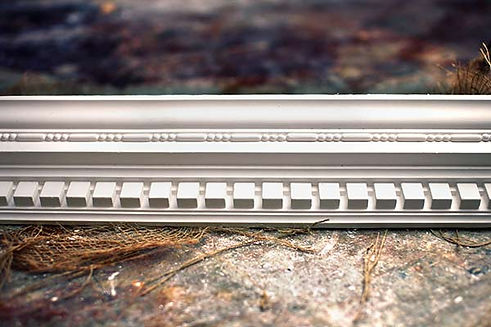
Fibrous Plaster Cornice
What is Fibrous Plaster?
Fibrous plaster has a thin, lightweight and modular construction consisting of hessian soaked in gypsum plaster which is then cast in a mould. It is made stronger with laths (thin flat strips of wood) and ribs which have the secondary purpose of fixing the moulding in place and supporting it.
In the late 19th century the fibrous plaster technique largely replaced solid lime and gypsum plaster for decorative plaster mouldings and it is still the principal method for making plaster cornices and other ornate mouldings today.
The technique of reinforcing gypsum plaster with hessian or canvas has actually been used for many thousands of years, with many experts believing it to predate the Pharaohs. However, modern fibrous plasterwork use in the UK can be traced back to a patent in 1856 made by French modeller, Leonard Alexander Desachy, which was based on a Parisian method.


Advantages Over Solid Plaster
Fibrous plaster cornices and other mouldings have numerous advantages over solid plaster, hence their unwavering contemporary popularity. For starters, fibrous plaster weighs much less and is better reinforced than its predecessor, allowing for mouldings to be easily manufactured in a studio such as ours rather than at the installation site.
The use of modular cast mouldings allows us to incorporate a great variety of ornament, both that which follows traditional authentic patterns and when creating something entirely fresh and bespoke. Incorporating a stock acanthi leaf into a cornice made to specific dimensions, for instance, saves having to model each leaf from scratch.
The fibrous plaster evolution resulted in a much more cost-effective, less labour-intensive plaster decoration. It meant that fine plaster mouldings were no longer the preserve of the richest members of society (and also meant .that that those people who could afford it could afford more of it)
Grand Designs For All
It wasn’t just domestic properties that benefitted from the new fibrous plaster method. Music halls, theatres, and other buildings where a grand effect was desirable but where, historically, budgets didn’t allow for lavish plaster ornamentation, could also take advantage.
Over the last hundred years, fibrous plaster has really found its feet, as increasingly flexible moulding compounds have made it possible to produce casts with fine sharp relief, undercut decoration, piercing and inlays, and modern plasters have increased strength and lightness.
To view our range of stock fibrous plaster cornices, please click here. To speak to us about a bespoke project, cornice or otherwise, contact us today.


